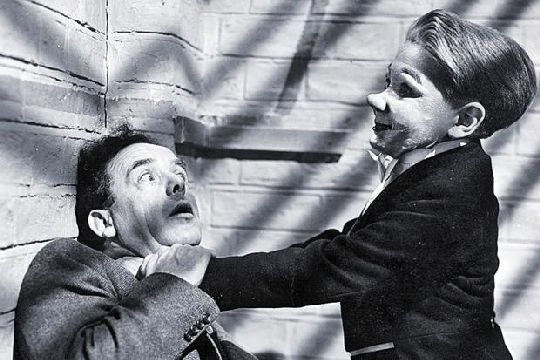Dead of Night (1945) 

Director: Cavalcanti, Charles Crichton, Basil Dearden, Robert Hamer
Cast: Mervyn Johns, Michael Redgrave, Roland Culver
Synopsis: An architect senses impending doom as his half-remembered recurring dream turns into reality. The guests at the country house encourage him to stay as they take turns telling supernatural tales.
Dead of Night is one of those movies that, if seen as a child, remains with you for the rest of your life. Watching it for the first time in more than thirty years, I was surprised by how much of it I clearly remembered, even though I’m pretty sure I’d only seen it once before. I was also impressed by how clever the movie is. It’s like contemplating the size of the universe — the more you think about it the more frazzled your brain becomes. Interestingly enough, Dead of Night actually gave rise to Hoyle’s (now discredited) Steady State Theory of Cosmology which proposes that while the universe is evolving, it’s also paradoxically unchanging.
The movie opens with architect Walter Craig (Mervyn Johns) pulling up outside the home of Eliot Foley (Roland Culver), who has invited him to reconstruct his farmhouse. Foley’s house looks disconcertingly familiar to Craig, and as his host ushers him inside and introduces him to his other guests, Craig’s disquiet grows into a low-key terror as he realises that everything he sees and every word that is spoken by the assorted guests are familiar to him from a nightmare he had the night before. The guests are intrigued by Craig’s claim, although one, a psychologist named Dr. Van Straaten (Frederick Valk) strives to give a scientific explanation for it. This prompts the other guests to recall their own brushes with the supernatural.
The first story sees racing driver Hugh Grainger (Anthony Baird) avoiding certain death when he declines to climb aboard a double decker bus. Grainger recognises the bus’s conductor (Miles Malleson) as the hearse driver from a strange vision he had while recovering in hospital from a car crash. Young Sally O’Hara (Sally Anne Howe) recalls an eerie incident in which she met a small boy in a secret room at a house during a Christmas party. Joan Courtland (Googie Withers) tells a supernatural tale in which her husband (Ralph Michael) sees in the mirror she has bought him a room which is different to the one in which he’s standing; the tone is lightened momentarily by Foley’s story in which he reveals how a golfer pays a high price for cheating during a game to decide which player will win the hand of a girl who can’t choose between them, before the tone becomes darker than ever with the story told by Dr. Van Straaten of a ventriloquist (Michael Redgrave) who finds himself becoming possessed by his dummy.
The end of the movie sees the gathering turning into the nightmare Craig foretold before he’s awaken by his wife. It was all a dream, you see — how corny is that? But then, the movie slaps its scoffing audience in its figurative face by having him receive a phone call from Foley inviting him to the farmhouse he is intending to have reconstructed. Craig tosses a coin to decide whether he’ll go, and then we see the same shot of him pulling up at the farmhouse that we saw at the start of the movie. So, is Craig suffering a recurring nightmare from which it is impossible for him to escape? Or is he perhaps just a character in the nightmare of some other, unseen, dreamer? Or do the events that we see really take place, to be replayed ad-nauseum in the mind of a mad man? At one point in Dead of Night, Foley wonders aloud whether he and his other guests exist only as characters in Craig’s dream, and then later whether they are real people powerless within its grip. These are almost throwaway lines, but they pose the same mind-bending conundrum as Craig’s recurring dream.
Dead of Night is an atypical product from Ealing, the studio more famous for its quintessentially British comedies. It was, in fact, made before the first of those comedies were released, and it’s very much a standalone picture both for that studio and British pictures of the era. The quality of most portmanteau movies generally varies from story to story, but apart from the golfing story, which is an ill-advised touch of light relief presumably inserted to relieve tension a little before hitting the audience with the particularly dark and powerful ventriloquist story, the quality of all the tales is uncommonly high. The ventriloquist’s story gives rise to one of the movie’s most nightmarish moments when, as Craig’s dream loses coherence to become a succession of linked images, we see the malevolent dummy approach him in a prison cell while a crowd of insanely grinning onlookers peer between the bars of his cell door. Truly the stuff of nightmares…
(Reviewed 27th December 2013)
httpv://www.youtube.com/watch?v=9SI6FBaeBEc
